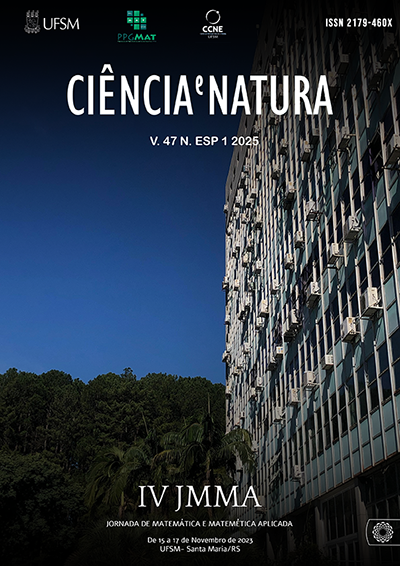PCA: a mathematical tool for the analysis of agricultural and livestock COREDEs in Rio Grande do Sul
DOI:
https://doi.org/10.5902/2179460X90532Keywords:
Principal component analysis, Spectral decomposition, Census of agriculture, COREDEsAbstract
This study aimed to reduce the original data matrix from the agricultural Regional Development Councils (COREDEs) of Rio Grande do Sul, utilizing information from the 2017 Agricultural Census. We commenced with a rigorous exposition on mathematical results underpinning Principal Components Analysis (PCA), culminating in an appliction of PCA that significantly reduced the initially collected data from 15 variables to only three components, which collectively explained approximately 87\% of the data variance. These insights have the potential to influence decision-making in agricultural policies and regional development strategies targeted at these COREDEs.
Downloads
References
Bartle, R. G. (1983). Elementos de an´alise real. Campus.
Freitas, C. A., Paz, M. V., & Nicola, D. S. (2007). Analisando a modernização da agropecu´aria ga´ucha: uma aplicação de an´alise fatorial e cluster. An´alise Econˆomica, 25(47), 121–149.
Hotelling, H. (1933). Analysis of a complex of statistical variables into principal components. Journal of educational psychology, 24(6), 417–441.
IBGE (2018). Censo Agropecu´ario 2017: resultados definitivos. IBGE.
Johnson, R. A. & Wichern, D. W. (2002). Applied multivariate statistical analysis. Prentice hall Upper Saddle River.
Jolliffe, I. T. (2002). Principal Component Analysis. Springer.
J¨oreskog, K. G. (1979). Basic Ideas of Factor and Component Analysis. In Joreskog, K.G. and Sorbom, D. (Eds.), Advances in Factor Analysis and Structural Equation Models (pp. 5-20). University Press of America.
Kageyama, A. & Leone, E. T. (1999). Uma tipologia dos munic´ıpios paulistas com base em indicadores sociodemogr´aficos. UNICAMP/IE.
Mardia, K. V., Kent, J. T., & Bibby, J. M. (1979). Multivariate analysis. Academic Press.
Poerschke, R. P. & Junior, F. d. J. M. (2020). An´alise multivariada de dados socieconˆomicos: um retrato da modernizac¸ ˜ao agropecu´aria nos coredes do rio grande do sul. Ciˆencia e Natura, 42, e13–e13.
Schneider, S. & Waquil, P. D. (2001). Caracterizac¸ ˜ao socioeconˆomica dos munic´ıpios ga´uchos e desigualdades regionais. Revista de Economia e Sociologia Rural, 39(3), 117–142.
Strang, G. (2019). Linear algebra and learning from data. SIAM.
Vidal, R., Ma, Y., & Sastry, S. (2005). Generalized principal component analysis. IEEE Transactions on Pattern Analysis and Machine Intelligence, 27(12), 1–15.
Ward, J. H. (1963). Hierarchical grouping to optimize an objective function. Journal of the American statistical association, 58(301), 236–244.
Downloads
Published
How to Cite
Issue
Section
License
Copyright (c) 2025 Ciência e Natura

This work is licensed under a Creative Commons Attribution-NonCommercial-ShareAlike 4.0 International License.
To access the DECLARATION AND TRANSFER OF COPYRIGHT AUTHOR’S DECLARATION AND COPYRIGHT LICENSE click here.
Ethical Guidelines for Journal Publication
The Ciência e Natura journal is committed to ensuring ethics in publication and quality of articles.
Conformance to standards of ethical behavior is therefore expected of all parties involved: Authors, Editors, Reviewers, and the Publisher.
In particular,
Authors: Authors should present an objective discussion of the significance of research work as well as sufficient detail and references to permit others to replicate the experiments. Fraudulent or knowingly inaccurate statements constitute unethical behavior and are unacceptable. Review Articles should also be objective, comprehensive, and accurate accounts of the state of the art. The Authors should ensure that their work is entirely original works, and if the work and/or words of others have been used, this has been appropriately acknowledged. Plagiarism in all its forms constitutes unethical publishing behavior and is unacceptable. Submitting the same manuscript to more than one journal concurrently constitutes unethical publishing behavior and is unacceptable. Authors should not submit articles describing essentially the same research to more than one journal. The corresponding Author should ensure that there is a full consensus of all Co-authors in approving the final version of the paper and its submission for publication.
Editors: Editors should evaluate manuscripts exclusively on the basis of their academic merit. An Editor must not use unpublished information in the editor's own research without the express written consent of the Author. Editors should take reasonable responsive measures when ethical complaints have been presented concerning a submitted manuscript or published paper.
Reviewers: Any manuscripts received for review must be treated as confidential documents. Privileged information or ideas obtained through peer review must be kept confidential and not used for personal advantage. Reviewers should be conducted objectively, and observations should be formulated clearly with supporting arguments, so that Authors can use them for improving the paper. Any selected Reviewer who feels unqualified to review the research reported in a manuscript or knows that its prompt review will be impossible should notify the Editor and excuse himself from the review process. Reviewers should not consider manuscripts in which they have conflicts of interest resulting from competitive, collaborative, or other relationships or connections with any of the authors, companies, or institutions connected to the papers.






